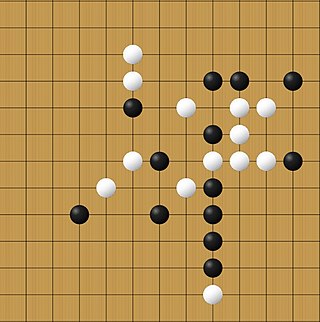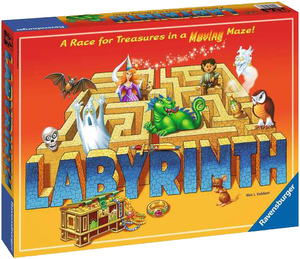
Pente is an abstract strategy board game for two or more players, created in 1977 by Gary Gabrel. A member of the m,n,k game family, Pente stands out for its custodial capture mechanic, which allows players to "sandwich" pairs of stones and capture them by flanking them on either side. This changes the overall tactical assessments players face when compared to pure placement m,n,k games such as Gomoku.

Kensington is an abstract strategy board game devised by Brian Taylor and Peter Forbes in 1979, named after London's Kensington Gardens, which contains the mosaic upon which the gameboard is patterned. It is played on a geometrical board based on the rhombitrihexagonal tiling pattern. The objective of the game is to capture a hexagon by occupying the six surrounding vertices. The game maintains an elegant simplicity while still allowing for astonishingly complex strategy. The placing and movement of tokens have been compared to nine men's morris.

Quoridor is a two- or four-player intuitive strategy game designed by Mirko Marchesi and published by Gigamic Games. Quoridor received the Mensa Mind Game award in 1997 and the Game Of The Year in the United States, France, Canada and Belgium.

Family Business is a card game of "mob vengeance" for 2 to 6 players, published by Mayfair Games in 1982, and then again in 1989.

Continuo is an abstract strategy game by Maureen Hiron which was first published in 1982 and now distributed in board game form by David Westnedge Ltd. In the U.K and U.S. Games Systems in the U.S. It is played by arranging patterns printed on a deck of 42 cards, each card being printed with a grid of 16 colored squares. The goal is to place cards so that the tiles match as many chains of color as possible. Continuo sold over 200,000 units in the United Kingdom alone within a few months of being launched. Continuo won a 1995 Mensa Select games award. The tag line on the box is "The one rule game for all the family".

Labyrinth is a board game for two to four players, published by Ravensburger in 1986.

Hare and Tortoise is a Eurogame designed by David Parlett in 1974 and first published by Intellect Games. In 1978 it was released by Ravensburger in Germany, and received generally positive reviews critically and won the 1979 Spiel des Jahres. It has since sold some 2 million units in at least ten languages. The current editions are published by Gibsons Games in the UK, Ravensburger in Germany and Rio Grande Games in the United States.

Hasami shogi is a variant of shogi. The game has two main variants, and all Hasami variants, unlike other shogi variants, use only one type of piece, and the winning objective is not checkmate. One main variant involves capturing all but one of the opponent's men; the other involves building an unbroken vertical or horizontal chain of five-in-a-row.
Skirrid is a board game designed for 2–6 players.

Isolation is an abstract board game published by Ravensburger in 1972 in Germany as Isola, and then published internationally by licensed game companies under the titles Stranded and Isolation.
Pinko Pallino is a 2-player abstract strategy game designed by Mirko Marchesi and published by Epta Games in 1995.
Orient Express is a crime fiction board game published by Jumbo and Just Games. The game is based on the 1934 novel Murder on the Orient Express by Agatha Christie. The game was designed by Jeff Smets and released in 1985. The game contains 10 different murder cases, each of which can be played only once. Five new plots were released in 1987.

Breakthru is an abstract strategy board game for two players, designed by Alex Randolph and commercially released by 3M Company in 1965, as part of the 3M bookshelf game series. It later became part of the Avalon Hill bookcase games. It is no longer in production. The game has been compared to Fox and Hounds, although it shows more characteristics of the Tafl games of the Middle Ages, such as Hnefatafl.

A Game of War is a book by Guy Debord and Alice Becker-Ho that illustrates a game devised by Debord by giving a detailed account of one of their table-top conflicts. It was first published in French as Le Jeu de la Guerre in 1987, but unsold copies were later pulped in 1991, along with other books by Debord, at his insistence when he left his publisher Champ libre. The book was reissued in 2006, with an English translation published by Atlas Press in 2008.

Macadam Bumper is a video pinball simulation construction set developed by ERE Informatique in France. It was first released for 8-bit computers in 1985, the Atari ST in 1986 and MS-DOS in 1987. The Atari ST and MS-DOS versions were released in the US as Pinball Wizard in 1988 by Accolade.
Mojo is a two-player, 3 in-a-row abstract strategy board game played with original and unique "thrice-sliced-dice". The pieces, handmade to order in India, are colored with non-toxic vegetable dye. The individual opposite ends of the pieces are marked with pips and numbered similar to regular dice - i.e. they total 7. It takes all 3 pieces of a color to make up a single die.

Hex is a turn-based strategy game developed by Mark of the Unicorn and published in 1985 for the then-new Atari ST and later for the Amiga. The player controls a unicorn that is trying to turn all the hexes on the game board to the same colour. Opponents attempt to turn them to a different colour and thus defeat the unicorn. As the unicorn levels up, new spells are added to its repertoire, but only 5 can be used at any given time.

4000 A.D. is a science fiction conquest board game published by Waddingtons in 1972.
Tokyo Express: The Guadalcanal Naval Campaign – 1942 is a board game published in 1988 by Victory Games.
Lose Your Shirt is a board game published in 1976 by Waddingtons.














